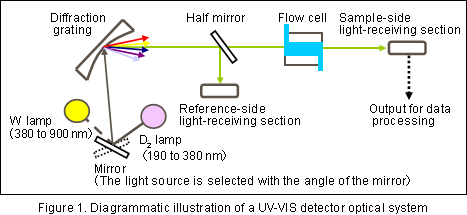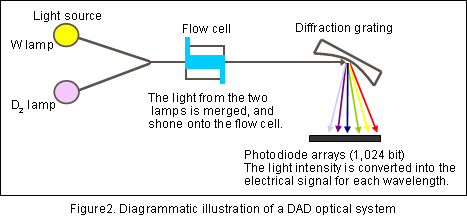7. Principle and Feature of Various Detection Methods (1)
Herein, the principles and features of frequently-used detectors are introduced. This chapter is "UV/UV-VIS detectors","Diode array detector (DAD, PDA: Photodiode Array Detector) ".
UV/UV-VIS detectors
UV/UV-VIS detectors are most frequently used to measure components showing an absorption spectrum in the ultraviolet or visible region.
A UV detector employs a deuterium discharge lamp (D2 lamp) as a light source, with the wavelength of its light ranging from 190 to 380 nm.
If components are to be detected at wavelength longer than this, a UV-VIS detector is used, which employs an additional tungsten lamp (W lamp).
Figure 1 shows the optical system. Light from the lamp is shone onto the diffraction grating, and dispersed according to wavelength. For example, when the measurement is performed with a wavelength of 280 nm, the angle of the diffraction grating is adjusted so that 280 nm light can shine on the flow cell. By monitoring the reference light divided from the light in front of the flow cell, the difference in light intensity can be determined between the back and front of the flow cell, and this is output as absorbance.

A many components have an absorption in the ultraviolet or visible region. However, attention should be given to the fact that different components have a different spectrum. Components with a large molar extinction coefficient can show a large peak even in small amounts. Thus, the concentration cannot be determined from peak size. Typically, the measurement is performed at a certain fixed wavelength.
If all of the components of a sample are to be detected with high sensitivity, the time program function can be used to measure each component along with its maximum absorption wavelength during the analysis.
Diode array detector (DAD, PDA: Photodiode Array Detector)
Photodiode arrays (semiconductor devices) are used in the detection unit. A DAD detects the absorption in UV to VIS region. While a UV-VIS detector has only one sample-side light-receiving section, a DAD has multiple (1024 for L-2455/2455U) photodiode arrays to obtain information over a wide range of wavelengths at one time, which is a merit of the DAD.
The idea is that spectra are measured at intervals of 1 second or less during separation by HPLC with continuous eluate delivery. If the measurement is performed at a fixed wavelength, components are identified from only their retention time; thus, a minor deviation in retention time can make identification of components difficult. In such a case, the DAD can be used to identify components by a comparison of the spectrum.
Figure 2 shows a DAD optical system.
DADs differ from UV-VIS detectors in that light from the lamps is shone directly onto the flow cell, light that passes through the flow cell is dispersed by the diffraction grating, and the amount of the dispersed light is estimated for each wavelength in the photodiode arrays.
Compared with a UV-VIS detector, the DAD has the following disadvantages: noise is large because the amount of light is small; the DAD is also susceptible to various changes, such as lamp fluctuations, because the reference light cannot be received. However, the DAD has recently been improved to reduce its difference in performance from UV-VIS detectors.

The results of a measurement with a DAD are shown in the contour map as in Figure 3. Convenient functions are provided, including a peak purity check and library search, as well as quantitative analysis with a specified chromatogram.

Why is a wavelength of 254 nm used?
Previously, the light source of a UV detector was a mercury lamp. This lamp was employed for a fixed wavelength of 254 nm in detectors because of having a bright line (a wavelength with extremely high energy) at 253.7 nm. Fortunately, many components containing benzene rings can absorb light at this wavelength, which enabled many samples to be analyzed with this fixed wavelength. Hence, the detection wavelength of 254 nm is sometimes used, even now.
However, most current UV detectors employ a D2 lamp as the light source, for which the wavelength can be changed. Usually, components are measured not uniformly at 254 nm, but at each component's maximum absorption wavelength, because high sensitivity is required for the measurement.
Here, a question is given. What is the wavelength of the bright line of a D2 lamp? The answer is 656.1 nm. Energy is scantly observed around this wavelength; only this wavelength has high energy. Using this fact, wavelength is checked for deviations in detectors. The L-2000 series detectors can be controlled accurately, because they are equipped with a mercury lamp for wavelength calibration to check the wavelength in the ultraviolet region.
